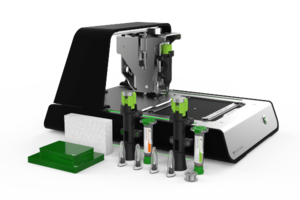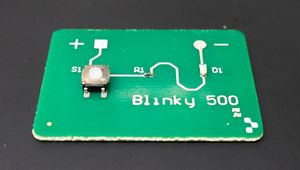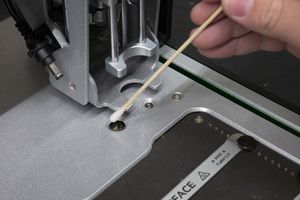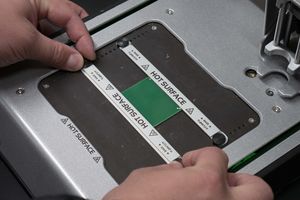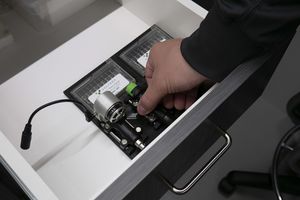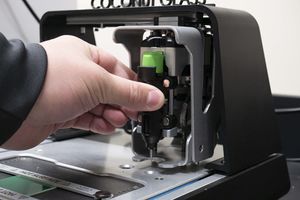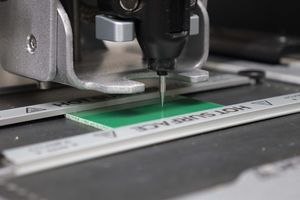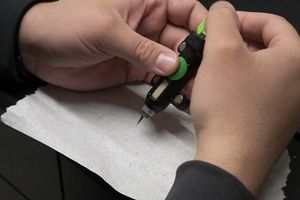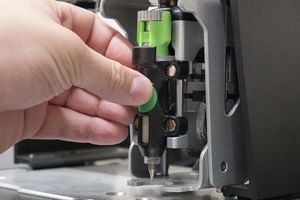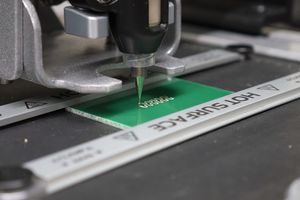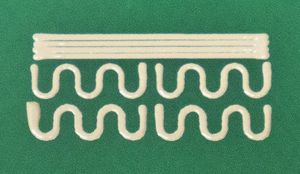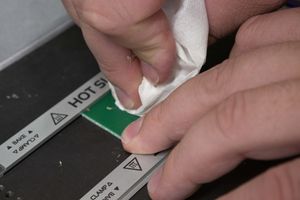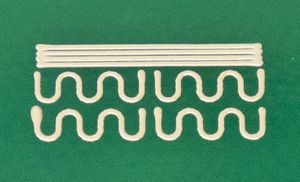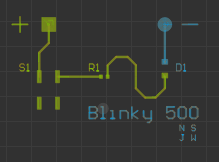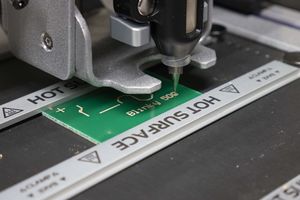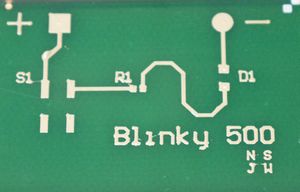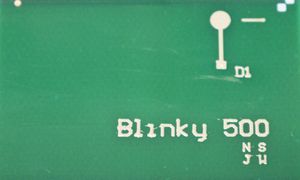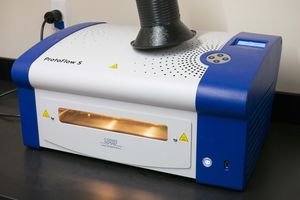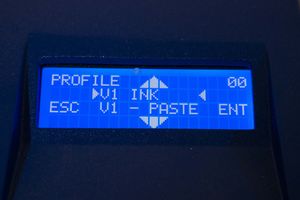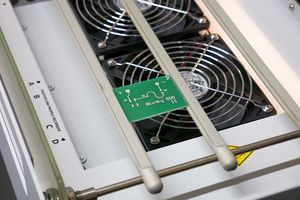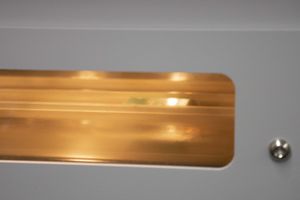Difference between revisions of "PCB Printer"
| Line 173: | Line 173: | ||
==Maintenance== | ==Maintenance== | ||
====General maintenance==== | ====General maintenance==== | ||
| + | The PCB Printer has a few items that need to be maintained by the student or the Ace. Refer to the table below to see each procedure, how often it should occur, and the the last completion of the specific task. | ||
====Specific Maintenance Tasks==== | ====Specific Maintenance Tasks==== | ||
| Line 179: | Line 180: | ||
!Frequency | !Frequency | ||
!Done By | !Done By | ||
| + | !Last Completion | ||
|- | |- | ||
| − | | | + | |General Cleaning |
| − | | | + | |Before and after each use, including ink/solder residue and drilled material |
| − | | | + | |Student |
| + | |N/A | ||
| + | |- | ||
| + | |Replacing Sacrificial Layer | ||
| + | |When the existing layer is worn through and can potential damage the heating bed | ||
| + | |Ace | ||
| + | | | ||
| + | |- | ||
| + | |Replacing Nozzle | ||
| + | |When the nozzle is clogged | ||
| + | |Student or Ace | ||
| + | | | ||
| + | |- | ||
| + | |Refrigerating the Dispensers | ||
| + | |Whenever they are not in use | ||
| + | |Student | ||
| + | |N/A | ||
| + | |- | ||
| + | |Switch Cleaning | ||
| + | |During Calibration stage using Isopropyl Alcohol and a giant Q-tip | ||
| + | |Student | ||
| + | | | ||
|} | |} | ||
{{#set: | {{#set: | ||
Revision as of 10:47, 11 June 2019
Make: Voltera
Model: V-One
Ace: Needed (Makerhub@georgefox.edu).
Location: PCB Lab
Description
The PCB Printer (Voltera V-One) rings quick turn PCBs to your desktop. Import your gerber file into the Voltera software, press print, and the V-One will bring your board to life. Use the drilling, solder paste dispensing, and reflow features to mount components onto your printed board, or mount components on a pre-fabricated board with ease.
Here is an example of this piece of equipment being used.
Insert video media here.
Documentation
Terminology
The following conductive inks and pastes are stocked in the PCB Lab.
Conductive Ink: AqueousSnake
- Use to lay conductive traces on substrates
Solder Paste: FuriousAnt
- Use only on boards that utilize Voltera's ink traces, such as the ink above.
Solder Paste Sn63 Pb37: ArmoredArmadillo
- Use only premade boards, such as ones from Sunstone Circuits
Training
Overview
PCB Printer is a fantastic tool for prototyping PCBs. After uploading Gerber files from Altium or a related software, Voltera will be able to print traces, pads, and bake them all in one location. However, the PCB Lab has a different tool for baking due to the amount of people it needs to accommodate, users will only be using the PCB Printer to print traces and pads. The Conductive Ink (used for Traces) is indicated by a green dot on the dispenser, the Voltera Solder Paste (used for Pads) is indicated by an orange dot on the dispenser, and the Manufactured Solder Paste (used for Pads) is indicated by a blue dot on the dispenser.
Before beginning with your PCB, it is imperative that it is completely flat, meaning no components are installed, as it will result in breaking the nozzle of the dispenser, or it will be unable to calibrate correctly.
Demonstration
To show a complete knowledge of the PCB Printer, the student will design a PCB in Altium or related software, print the traces/pads, and transition to the Reflow Oven. As a part of the process, the student will also perform correct set up and shut down procedures, all of which can be found in the General Procedure below.
General Procedure
Using the Voltera to create single-sided boards with NO vias or holes.
- Suppose you were to make holes...
- This board in particular does not have any holes, so this entire step can be skipped for this procedure, however, these are the steps to take if you need to drill holes in the future.
- Ready the Ink
- The ink is most usable when it reaches room temperature, so we have to let it warm up in advance.
- Reference the Current Inks and Paste for information on the what the PCB lab is currently stocked with.
- Grab the correct conductive ink from the fridge, and let it warm up to room temperature, about 15-30 minutes. It is labeled with a green sticker.
- Software Setup
- Download the files for this project here.
- Power on the Voltera.
- Open the Voltera Windows application.
- Select "Print" and then "Simple." "Print" indicates that we want to print traces, and "Simple" indicates that the board is not pre-fabricated. If we had a pre-fabricated board, we would instead select "Aligned" so we can align the holes.
- Next we need to add the proper conductive ink, which is the same conductive ink you acquired in step 1.2.
- Load the ink file from the project files. This is the Top Layer Gerber file.
- Cleaning the Sensors
- Take a cue tip and dip it into the isopropyl alcohol. The cue tip should be moist, but NOT soaked. Dab the cue tip on a paper towel to dry it slightly.
- Clean the calibration switches by rubbing them with the cue tip.This will help clear out any crap that could hurt the sensor.
- Clamping the Substrate
- Acquire a 1.5" by 2" blank board. They are located in the one of the drawers.
- Slide the board underneath the clamps on the Voltera, push the clamps towards each other, and finger-tighten the thumb screws. You should not be able to move the board once you clamp them down.
- Mounting the Probe
- Pull the probe from one of the drawers. The probe should have a large metal tip, do not confuse it with the dispenser.
- Remove the cap and place it near the Voltera.
- Mount the probe onto the magnetic gantry. It should snap into place and the contacts should align.
- Positioning and Probing
- Click "Outline." This will show you where the Voltera thinks the board is. It will move the probe around the printer surface and determine how close the dispenser will need to be to the board.
- Repeat step one until the outline is centered with the board. Click and drag the circuit in the Voltera application to move the outline.
- You MUST ensure the outline does not collide with the clamps AND does not exceed the dimensions of the board! Do NOT proceed until this is checked!
- In the next step, Click "Probe" and wait for the Voltera to finish its measurements.
- Remove the probe, replace the cap, place the probe back in the drawer, and proceed.
- Priming the Conductor
- Ensure 15 minutes have passed before beginning the next step. This helps the ink flow easier, so the dispenser should not be cold to the touch.
- Read carefully. The Voltera application explains this step well. Follow the on-screen instructions before moving on to the next step. Some tips/tricks/warnings:
- Nozzles are fragile! You would be surprised how easy it is to break one. Treat this process with care!
- Hold the dispenser over a paper towel to prevent ink from getting everywhere.
- If you need to wipe the nozzle, do so gently and use a cotton swab found in the drawers.
- Ink should not be flowing quickly out of the dispenser when you finish priming, but a very small amount of flow is OK.
- Mount the dispenser.
- Calibration
- Click "Advanced." Start with the Z at 0.10 mm and the E at 0 um. Adjust the Voltera to these values, as it is a safe distance for the dispenser.
- Click "Calibrate." The Voltera will lay down a test print. Pay close attention to the amount and consistency of the ink.
- The example below has slightly too much ink. Notice how a portion of the horizontal lines touch and some parts of the ink glob up.
- In this case, to make an adjustment, the ink height was set to a Z of 0.09 mm and the flow was set to an E of -10 um. This dispenses less ink than before.
- You may need to do the same or make different adjustments. Whatever you do, do NOT run the nozzle into the board! The nozzle will break!
- If an adjustment was made, wipe the board clean with a paper towel (shown below) and/or clean it with isopropyl alcohol and repeat the calibration.
- The example below is a more acceptable test print. Strive for this consistency. If your board looks right, proceed.
- Click "Next," and wipe the board clean a final time, as you are now preparing to print your whole circuit.
- Top Layer Print
- The Voltera will print what is selected in green. Below is an example of a portion of the board selected. Ensure the portion you want to print is selected (in this case, select everything.) Remember that blue lines will not be printed.
- Click "Start." Let the Voltera finish its process. If a portion of the print fails or is incorrect, you can stop mid-print, or wait until it is finished and redo that selection. Also shown below is an example of a portion of ink that globbed up. The portion was wiped and can be reprinted.
- Remove the conductive ink, put the cap back on, and return the conductive ink to the fridge!
- When you reach the instruction titled "Flip Board," you are done. We want to bake these traces on the Reflow Oven before we do anything else to the board.
- Unclamp the board from the Voltera, and remember that the traces are still wet, so do not smear them around.
- Consult the Reflow Oven wiki and complete that process.
- Preparing for Solder Paste
- You should now have a PCB with traces baked on it! Time to make those pads for placing components.
- Take a burnishing pad from one of the drawers. Rub the substrate with the pad until the traces have a shine to them, rather than a dull appearance.
- Replace the burnishing pad back into the drawer. This cleans the surface of the traces and makes them look super shiny.
- Aligning the Paste
- This process will help the Voltera know where it needs to print solder. The user gives it two locations where the pads should go, and the Voltera can use the Gerber files to determine where else pads need to go.
- At this time, retrieve the solder paste from the fridge and set it out to warm. The correct paste is labeled with a orange sticker.
- Take the board back to the Voltera and clamp the board into place. Again, you should not be able to move the board after it is clamped.
- Open the Voltera application and choose "Solder," and choose the proper paste. In this case you want the orange-labeled paste.
- Clean the calibration switches, mount the probe, and proceed.
- Click 'Move to feature." This will move the probe to a pre-determined feature and should not be aligned properly on the first go. It is your job to align it correctly.
- First, use the arrow keys to roughly align the feature with the probe. This process will help the Voltera know where it needs to put the pads.
- Next, click "Lower," and use the arrow keys to fine-tune the alignment. Your precision in these steps is key to getting solder paste in the correct places.
- Click "Measure" when the alignment is correct. The board will be probed and the head will move to a second feature.
- Repeat steps 8 and 9.
- Click "Measure." The alignment is now finished.
- You can confirm the alignment by clicking various features and seeing if the head moves to the right position. If something is off, you can go back and realign if necessary. Proceed until you need to measure the height of the board.
- Click "Probe." This will measure the height of the board and determine how far away the dispenser needs to be from the board.
- Once it finishes probing, remove the probe and replace it in the drawer.
- Priming the Paste
- Refer to the priming directions in step 7 before mounting the dispenser.
- Once it is primed, mount it and proceed.
- Click "Dispense." The paste will dispense onto all of the selected pads.
- Strive for good coverage of paste, preferably covering most of the pad, if not all of it.
- Remove the dispenser. Twist the knob clockwise to back off the paste. Put it back in the fridge, and quit the Voltera app.
- Unclamp the board from the Voltera. Remember that you are handling a board with wet paste. Clean up!
- You are now done with the PCB Printer! Refer to the Pick and Place as well as the Reflow Oven wikis for the remainder of the process.
- Components
- The board consists of a button, a 680Ω resistor, and an LED. Attach a fixed 5VDC connection to the + and -, and the LED should illuminate.
Safety
- When the PCB Printer is moving and doing its thing, just let it be. Interfering will result in breaking equipment and possibly hurting yourself, especially with the drill. Voltera gives excellent advice/steps for their PCB fabrication process, be sure to follow them.
- If you feel like you do not know what you are doing, ask someone for help. You could damage both the equipment and possibly hurt yourself. Do not hesitate to ask or confirm at any point during the process.
Certification
Foxtale Quiz
Troubleshooting
- Drilling
- If your holes seem to be all out of wack, be sure to confirm the following: you should be using the vacuum to suck up any debris that comes from drilling your board while it is drilling. The pieces can interfere with your part.
- If they seem to be drilling in the wrong places, then it probably isn't aligned correctly. Go back in the process and start over.
- Calibration/Alignment
- During the probing process, be sure that your board is completely flat and that the clamps cover a minimal amount of the board while keeping it secure. If the probing hits the claps or runs off the board, the calibration is no good. Go back to the initial stages where you align holes/indicate where to print traces.
- When holes are available during the Alignment stage, always use them to align your board. NEVER use pads or traces unless you absolutely have to. Holes are much easier to align with.
- Printing Traces/Solder
- Be sure that the dispenser has been warming up to room temperature for at least 15 minutes so the ink can flow smoothly.
- If the ink does not seem come come out even when you're priming the dispenser, chances are that it is clogged. Remove the tip, notify a PCB Lab worker, and install a new tip (ask a worker if you don't know how).
Maintenance
General maintenance
The PCB Printer has a few items that need to be maintained by the student or the Ace. Refer to the table below to see each procedure, how often it should occur, and the the last completion of the specific task.
Specific Maintenance Tasks
| Maintenance Procedure | Frequency | Done By | Last Completion |
|---|---|---|---|
| General Cleaning | Before and after each use, including ink/solder residue and drilled material | Student | N/A |
| Replacing Sacrificial Layer | When the existing layer is worn through and can potential damage the heating bed | Ace | |
| Replacing Nozzle | When the nozzle is clogged | Student or Ace | |
| Refrigerating the Dispensers | Whenever they are not in use | Student | N/A |
| Switch Cleaning | During Calibration stage using Isopropyl Alcohol and a giant Q-tip | Student |
The Voltera V-One brings quick turn PCBs to your desktop. Import your gerber file into the Voltera software, press print, and the V-One will bring your board to life. Use the solder paste dispensing and reflow features to mount components onto your printed board, or mount components on a pre-fabricated board with ease. [1]
The current Ace of the PCB Printer is Needed (Makerhub@georgefox.edu).
Documentation
Current Inks and Paste
The following conductive inks and pastes are stocked in the PCB Lab.
Conductive Ink: AqueousSnake
- Use to lay conductive traces on substrates
Solder Paste: FuriousAnt
- Use only on boards that utilize Voltera's ink traces, such as the ink above.
Solder Paste Sn63 Pb37: ArmoredArmadillo
- Use only premade boards, such as ones from Sunstone Circuits
Terminology
The Voltera utilizes many pieces of equipment. It is important to be able to distinguish them, especially when trying to explain troubleshooting issues. Here are the items you should familiarize yourself with:
(Pictures to add)
Sacrificial layer
Training
Level 1
Successful completion of level 1 training will grant access to:
- Using the Voltera to create single-sided boards with NO vias or holes.
- Ready the Ink
- Reference the Current Inks and Paste for information on the what the PCB lab is currently stocked with.
- Grab the correct conductive ink from the fridge. It is labeled with a green sticker.
- Set the conductive ink on the table, allowing to begin to warm to room temperature.
- Software Setup
- Download the files for this project here.
- Power on the Voltera.
- Open the Voltera Windows application.
- Select "Print" and then "Simple."
- Add the proper conductive ink. This is the same conductive ink you acquired in step 1.3.
- Load the ink file from the project files. This is the Top Layer Gerber file.
- Click "Next."
- Cleaning the Sensors
- Take a cue tip and dip it into the isopropyl alcohol. The cue tip should be moist, but NOT soaked. Dab the cue tip on a paper towel to dry it slightly.
- Clean the calibration switches by rubbing them with the cue tip.
- Click "Next."
- Clamping the Substrate
- Acquire a 1.5" by 2" blank board. They are located in the one of the drawers.
- Slide the board underneath the clamps on the Voltera, push the clamps towards each other, and finger-tighten the thumb screws.
- Click "Next."
- Mounting the Probe
- Pull the probe from one of the drawers.
- Remove the cap and place it near the Voltera.
- Mount the probe onto the magnetic gantry. It should snap into place and the contacts should align.
- Click "Next."
- Pull the probe from one of the drawers.
- Positioning and Probing
- Click "Outline." This will show you where the Voltera thinks the board is. It will move the probe around the printer surface.
- Repeat step one until the outline is centered with the board. Click and drag the circuit in the Voltera application to move the outline.
- You MUST ensure the outline does not collide with the clamps AND does not exceed the dimensions of the board! Do NOT proceed until this is checked!
- Click "Next."
- Click "Probe" and wait for the Voltera to finish its measurements.
- Click "Next."
- Remove the probe, replace the cap, place the probe back in the drawer, and click "Next."
- Priming the Conductor
- Ensure 15 minutes have passed before beginning the next step. The dispenser should not be cold to the touch.
- Read carefully. The Voltera application explains this step well. Follow the on-screen instructions before moving on to the next step. Some tips/tricks/warnings:
- Nozzles are fragile! You would be surprised how easy it is to break one. Treat this process with care!
- Hold the dispenser over a paper towel to prevent ink from getting everywhere.
- If you need to wipe the nozzle, do so gently and use a cotton swab found in the drawers.
- Ink should not be flowing quickly out of the dispenser when you finish priming, but a very small amount of flow is OK.
- Mount the dispenser.
- Calibration
- Click "Advanced." Start with the Z at 0.10 mm and the E at 0 um. Adjust the Voltera to these values.
- Click "Calibrate."
- The Voltera will lay down a test print. Pay close attention to the amount and consistency of the ink.
- The example below has slightly too much ink. Notice how a portion of the horizontal lines touch and some parts of the ink glob up.
- In this case, to make an adjustment, the ink height was set to a Z of 0.09 mm and the flow was set to an E of -10 um.
- You may need to do the same or make different adjustments. Whatever you do, do NOT run the nozzle into the board! The nozzle will break!
- If an adjustment was made, wipe the board clean with a paper towel (shown below) and repeat step 9.
- The example below is a more acceptable test print. Strive for this consistency. If your board looks right, proceed.
- Click "Next."
- Wipe the board clean a final time.
- Click "Next."
- Top Layer Print
- The Voltera will print what is selected in green. Below is an example of a portion of the board selected. Ensure the portion you want to print is selected (in this case, select everything.) Remember that blue lines will not be printed.
- Click "Start." Let the Voltera finish its process. If a portion of the print fails or is incorrect, you can stop mid-print, or wait until it is finished and redo that selection. Also shown below is an example of a portion of ink that globbed up. The portion was wiped and can be reprinted.
- Remove the conductor, replace the cap, and return the conductive ink to the fridge!
- When you reach the "Flip Board," you are done. Quit the Voltera application.
- Unclamp the board from the Voltera. Remember that the traces are still wet.
- The Voltera will print what is selected in green. Below is an example of a portion of the board selected. Ensure the portion you want to print is selected (in this case, select everything.) Remember that blue lines will not be printed.
- Baking the Traces
- Switch over to the Reflow Oven.
- Power the Reflow Oven on.
- Select "V1 INK."
- The oven will warm up. When its ready, press "Enter" to open the tray.
- DANGER: The rails could be HOT! Take caution. Place the board securely on the rails.
- Press "Enter" to close the tray.
- The preheat will take 2 minutes. The baking process takes about 30 min.
- The drawer will automatically open to initiate the cool down phase. DO NOT remove the board until the oven says all the stages are complete. DANGER: The rails are HOT!
- When cool down is complete, remove the board from the oven.
- Switch over to the Reflow Oven.
- Preparing for Solder Paste
- Take a burnishing pad from one of the drawers.
- Rub the substrate with the pad until the traces have a shine to them, rather than a dull appearance.
- Replace the burnishing pad back into the drawer
- Aligning the Paste
- At this time, retrieve the solder paste from the fridge and set it out to warm. The correct paste is labeled with a orange sticker.
- Take the board back to the Voltera.
- Clamp the board into place.
- Open the Voltera application and choose "Solder."
- Choose the proper paste. In this case you want the orange-labeled paste.
- Clean the calibration switches.
- Mount the probe. Click "Next."
- Click 'Move to feature." This will move the probe to a pre-determined feature. It will not be aligned properly.
- First, use the arrow keys to roughly align the feature with the probe.
- Next, click "Lower," and use the arrow keys to fine-tune the alignment. Your precision in these steps is key to getting solder paste in the correct places.
- Click "Measure" when the alignment is correct. The board will be probed and the head will move to a second feature.
- Repeat steps 9 and 10.
- Click "Measure." The alignment is now finished. Click "Next."
- You can confirm the alignment by clicking various features and seeing if the head moves to the right position. If something is off, you can go back and realign if necessary.
- Click "Next."
- Click "Probe." This will measure the height of the board.
- Remove the probe and replace it in the drawer.
- Priming the Paste
- Explain the priming process
- Mount it. Click "Next."
- Click "Dispense." The paste will dispense onto all of the selected pads.
- Strive for good coverage of paste. See the picture below.
- Click "Next."
- Remove the dispenser. Twist the knob clockwise to back off the paste. Put it back in the fridge. Click '"Next."
- Quit the Voltera app.
- Unclamp the board from the Voltera. Remember that you are handling a board with wet paste.
- Pick and Place Components
- Clamp the board onto the Pick and Place.
- Power on the machine. The power switch is on the back.
- The arrow keys control the menu. These will be used to select things.
- Select "Place." Select "Manual."
- To move the turntable, select "Turntable," and use the arrow keys to move it clockwise or counterclockwise.
- The necessary components should be stocked in the slots in the turntable. If components are missing, contact any of the PCB lab staff.
- Turn on the Marshall monitor. This will help with viewing components.
- The Pick and Place is a like a vacuum machine. Its operation is straightforward.
- Move the gantry to the desired component. Press down (but not all the way) to stick the nozzle to the component.
- Move the gantry back to board. Move the component to its correct position so it appears to be close the pads. Lower the component about half a centimeter above the board.
- Turn the brake on with the arrow keys.
- Use the fine adjustment knobs at the bottom of the machine along with the monitor to perfectly align the component. Remember, you can swivel the camera in order to look down two different axes.
- When aligned, select "Place." The machine will automatically place the part to the position you set it to.
- Move the turntable to retrieve your next part.
- Repeat steps 1 through 6 until your board is complete.
- Remove your board from the clamps. Caution: Handle your board with care. Your components are not soldered and can easily dislodge from the paste!
- Turn off the Pick and Place machine.
- Reflow.
- Power on the oven.
- Select "V1 Paste." The warm-up period is longer this time.
- Place your board in the oven. DANGER: THE RAILS ARE HOT.
- Select "Enter."
- Reflow takes about three minutes. When it's done, the drawer will automatically open to initiate the cool down phase. DANGER: The rails are HOT! DO NOT remove the board until the oven says all the stages are complete. The solder paste is actually solidifying.
- When the cool down process is done, remove the board. The rails are probably still hot! Select "Enter" to close the oven drawer.
- Turn off the oven.
- Testing!
- Take the board over to the power supply.
- Ensure to use the fixed 5V connection on the power supply. Attach the positive and negative leads. Power on the PSU and press the button. The LED should illuminate!
Congrats! You're done. Got it all? Good. Why don't you go ahead and take the quiz.
Dispensing Tips
The Perfect Print
Two main factors affect the quality of your print.
Flow rate
Print height
Priming Conductors
Ideally, you should never have to prime the conductors. After a conductor has been primed correctly and used in the Voltera, it "closes" the dispenser. When done, you should be able to pull it off the mount and put the --- back in the fridge.
However, this is not always the case. If a student
Installing a New Cartridge
- Remove the nozzle CAREFULLY
- Dissamble sheath by twisting green part clockwise
- Remove dispenser
- clean dispenser
- press downwards on the sheath to loose the cartridge
- remove the cartridge
- proceed to chuck the cartridge in the nearest garbage can
- wind the dispenser clockwise until it cant clockwise anymore
- acquire new cartridge
- remove top and bottom green caps SAVE THEM
- insert the cartidge with the label facing the back, in other words, the label should not be viewable through the window on the sheath
- insert the dispenser and lock it in by twisting the green part counter clockwise
- carefully REPLACE NOZZLE, use fingers first and then pliers!44
Dev TODO
- Change the gerber file to remove the solder paste on the lead pads
